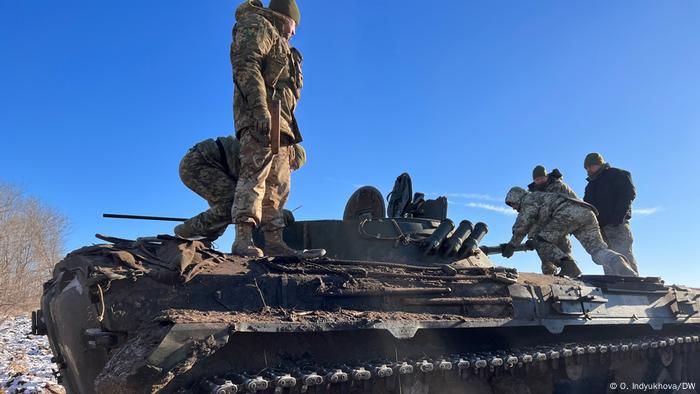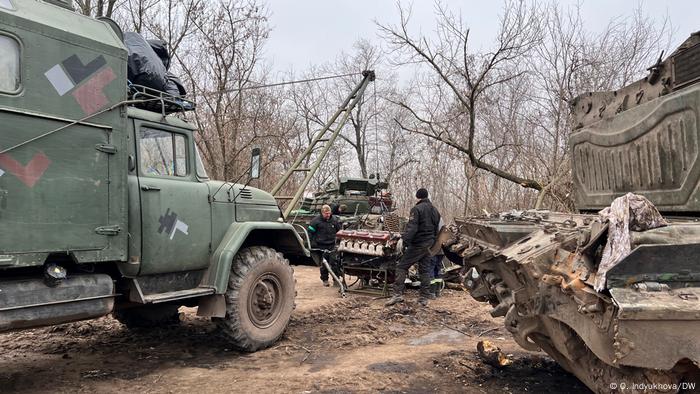Members of a Ukrainian armored brigade taking part in the fighting near Bakhmut report on the situation at the front – and explain to DW why they are currently dependent on modern Western equipment.

Ukrainian soldiers near Bakhmut
An icy, biting wind is sweeping across the steppe near Donetsk. The thermometer shows minus 17 degrees, the front where fighting for the cities of Bachmut and Soledar is only a few kilometers away. Soldiers from a Ukrainian tank brigade are practicing in the middle of the field. A few days ago they were withdrawn from the fighting at Bakhmut for a brief lull in the fighting. To get to the soldiers, you have to walk several kilometers across country.
“Well? Is it difficult to walk in a bulletproof vest? Are your arms and legs already freezing?” asks Ihor, an officer in the armored brigade, on the way to the battalion's location. “Imagine the boys lying in the frozen trenches where you're not allowed to light ovens, lest positions be given away.”
During a break to recover, the soldiers talk to DW. Not everyone gives their names, not everyone wants to be photographed. Some have relatives in the occupied territories, and their families don't even know that they are at the front.
“Does nobody in Russia look at the casualties?”
According to officers of the armored brigade, the balance of forces in the area is currently about ten Russian soldiers to one Ukrainian. On this sector of the front, the Ukrainian soldiers mainly deal with the Russian private army “Wagner”, which recruits prisoners from Russian prisons.

Ukrainian military near Bakhmut
The positions at Bakhmut and Soledar are very close together, says Oleh, one of the brigade commanders. Again and again the soldiers would be involved in close combat. “We can even hear the orders of the enemy commanders,” says Oleh.
The approximately 40-year-old infantryman Ihor is visibly exhausted – like everyone here. “The Ukrainian military is fighting on the edge of human strength,” he says. “We have no way of sleeping”. They are under fire day and night. Again and again there are attacks by the Russian infantry.
An officer, also named Ihor, says small Russian groups of 10 to 15 men are moving toward the Ukrainian positions “in waves” – right into the crossfire from the Ukrainian trenches. “We shoot, they die – there are piles of corpses on the field. Then the next group comes. They don't even help their wounded, they just keep moving towards us,” Ihor said.
“We lose people too. But I don't understand it: You have such huge losses. Doesn't anyone look at them?” Asks Infantryman Ihor. His comrade Dmytro says that “it's hard to endure all this. But we have no other choice. I want and need to defend my country, my family so that we have a future.”
The problems of Ukraine with the “Soviet tank heritage”
In order to continue their counter-offensive and liberate more occupied areas, the Ukrainian forces needed more equipment and weapons – preferably of non-Soviet design, say the commanders of the armored brigade.
Their engineers lead us to a couple of Soviet T-72 tanks, which they repair in the middle of the field in the open air after the fighting. Tool boxes and generators are on the floor. A truck with a crane pulls the engine block out of a T-72 tank. Engineer Andriy says that the engine stalled once in the middle of a fight, but “miraculously, the mechanic restarted it and the crew was able to save themselves.” “See this hole in the engine? It's gone,” says Andrij.
The mechanics exchange the old block for a new engine. However, it is only “new” to a limited extent. All spare parts for the T-72 are made in Russia, and Ukraine has long stopped buying them. “We still have spare parts in stock. But some things are missing. Then we cannibalize our damaged or captured Russian tanks,” says Andrij.

Replacing an engine in a Soviet T-72 tank
According to him, the Ukrainian army should get rid of “Soviet tank heritage” and all Soviet equipment. It does not stand up to comparison with modern equipment and can therefore hardly protect the soldiers. His deputy commander Konstantin agrees: in order to have a greater advantage at the front, the Ukrainian military needs Western weapons and equipment. The Russian army can only be defeated with modern technology.
“The Russians are afraid of the leopard”
Battalion commanders tell DW their soldiers would like to get new tanks as soon as possible because they “want to complete the liberation of Ukrainian territory as soon as possible.” Within the troops, the capabilities of the German Leopard tanks are discussed, but also how Germany is discussing the delivery of such tanks to Ukraine. There is also talk of the armored personnel carriers promised by the western partners – the German Marder and the American Bradley.
“The Leopard is what we need now. The high-precision sights and night vision devices work in any weather. Above all but the Russians are afraid of the leopard,” says officer Konstantin.
Volunteers tirelessly bring relief supplies to Bachmut
Meanwhile, mechanic Serhij is welding on a more than 50-year-old radiator in the open air. Serhiy has been in the army since 2014 and his hands are completely bruised from patching. “The Ukrainian armed forces need Western equipment, preferably with spare parts and repair logistics,” he says. Serhij is convinced that he can also repair Western equipment: “There are no major differences in the engines,” says Serhij. “The main thing is that I know how to get everything going again!”
Serhij and his comrades repair several tanks, armored personnel carriers and trucks under time pressure. The battles at Bachmut and Soledar are becoming increasingly fierce. The engineers in the tank battalion hardly get any sleep either. They say you have to “hold out”. Officer Ihor sees no other option either. “This war is terrible,” he says. “But we must win so that we can continue to live in freedom.”
Adaptation from Russian: Markian Ostaptschuk